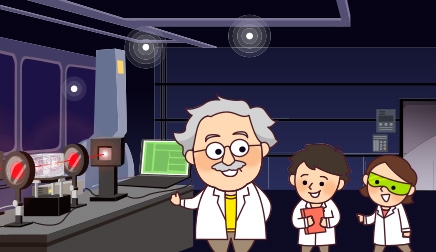 Home > Professor lights > Vol.08 Kentaro UESUGI
Home > Professor lights > Vol.08 Kentaro UESUGI
Vol.08 Kentaro UESUGI
A professional in analysis and
experimentation shows us things
that can only be seen here at SPring-8

Chief Scientist, Coordinator
Scattering and Imaging Division
Center for Synchrotron Radiation research
Japan Synchrotron Radiation Research Institute (JASRI)
June 16, 2023 Affiliation, title, and other information are as of the time the article was published.
After encountering unexpected trouble, the asteroid explorer Hayabusa launched by the Japan Aerospace Exploration Agency (JAXA) in 2003 finally returned to Earth in June 2010 along with particles it collected from an asteroid called Itokawa. In 2014, its successor space probe called Hayabusa2 was launched, and 6 years later brought back pristine material from the interior of the asteroid Ryugu. The analysis of this unknown material required advanced techniques. A person who played a key part in this analysis is Dr. Kentaro Uesugi who is here introduced on our website as a professor light. Dr. Uesugi is a professional in analysis and experiments and busily involved in research in various fields including materials such as rubber and metals, as well as geology, and life science. We asked him about his daily activities.
X-ray synchrotron radiation facility at SPring-8 is ideal for looking inside small objects
Continuing to improve experimental setups is a never-ending task
“Need someone with a strong body who can use a computer”
Analysis of Ryugu particles prepared over 5 years
Three evidence patterns pointing to a connection between Ryugu and water
Until we are totally convinced that the first data we acquired is correct
How a baseball boy switched over to a researcher career
If we all work together, we can double the fun and halve the pain!
X-ray synchrotron radiation facility at SPring-8 is ideal for looking inside small objects

Countless analyses and experiments have been conducted here.
Dr. Uesugi has been involved with SPring-8 since he was a graduate student. We first asked him about what we can find using “SPring-8.”
“SPring-8 is a synchrotron radiation facility operated at the world’s highest electron energy. Synchrotron radiation contains light of all wavelengths but this facility utilizes highly intense X-rays that are concentrated in a narrow spectral range,” Dr. Uesugi started explaining about SPring-8. Such highly intense X-rays are ideal for extracting weak signals.
To view a sample with a visible light microscope, you usually first look at the sample illuminated by light at a low magnification such as 5x. After identifying the area of interest you want to observe, you then gradually increase the magnification to 10x, 50x and so on while focusing on even finer details.
“However, sometimes just turning the revolving nose piece of the microscope to change the magnification isn’t enough to let you see the target you want. So, you adjust the focus and area you are viewing. You also need to increase the light intensity.”
This means that if you want to see something really tiny such as the particles brought back from Itokawa and Ryugu, you need high-brightness light. Synchrotron radiation X-rays are very suitable for this purpose. This is the reason why the huge SPring-8 facility is called the "big microscope.”
The term X-rays may remind you of the X-rays used in medical diagnosis so you might wonder if these are the same thing.
"X-ray imaging" is an examination method widely used to see the interior of a body or object. A unique feature of X-rays is that when passing through a material, they bend sharply in a different direction when certain conditions are met. This bending action is called “diffraction” and gives us a view revealing the periodic structure of the material.
The actual technical term we use for this phenomenon is “X-ray diffraction.” This represents the periodic structure of a material. In other words, we can identify the properties of a material if we know the angle at which the X-rays bend when they pass through a material. SPring-8 uses three techniques including this diffraction, X-ray imaging, and spectroscopy, that is emitted or reflected from a material when irradiated by X-rays. These techniques are useful for examining the state of materials and by using SPring-8 we can obtain information about small objects and confined areas.
Continuing to improve experimental setups is a never-ending task
Well now, what kind of work does Dr. Uesugi actually do at SPring-8?
“I started working here in April 2000. Since then, I have built experimental setups using SPring-8 X-ray beamlines and have been running experiments together with users in order to derive the analytical results that they want,” says Dr. Uesugi.
Currently, there are 57 beamlines at SPring-8. Dr. Uesugi is involved in work with 4 of these beamlines. He supports users all the way from the experiment plan through to the actual experiments, as well as writing papers and reports presenting the results from these experiments.
Among these tasks, his main job is fabricating the experiment setup and equipment. He also writes papers himself and gives presentations at conferences to publicize the setup and equipment he constructed.
“Basically, my main job is a beamline scientist. It's the kind of work that starts from a first step of a user’s requirements as SPring-8.”
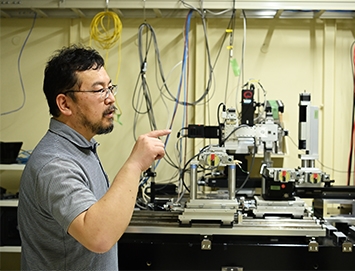
By the way, what field of users bring their requests to Dr. Uesugi?
“It really varies. One time, geologists in the earth science field told me that they wanted to investigate the viscosity of magma. On another occasion, I received a request from researchers in Switzerland to analyze the brainstem of a mouse. Other requests come from the fields of materials science, biology and electrical batteries, so my work responds to all kinds of requests regardless of whether these come from industry, academia or a specific field,” says Dr. Uesugi.
At times, he even assists in police investigations by giving expert appraisals, so he feels “ready for anything.” Since X-rays are an effective tool for seeing inside of materials, he knows that he can handle taking a look inside nearly anything that a user might request.
Dr. Uesugi talks happily about his job. What is it about this job that attracts him so much?
“It's fun to fabricate an experimental setup and it's also interesting to be able to do new research with users that no one has ever done before,” says Dr. Uesugi.
Dr. Uesugi himself designs experimental setups and equipment from scratch, procures parts, and temporarily assembles them. Then, if it is likely to work, he gets serious about assembling the actual equipment for the experiment.
“No experimental setup is ever really complete. It is always growing in a kind of never-ending task. That's why I can't let myself stop in the middle of a project,” he says with a laugh.
“Need someone with a strong body who can use a computer”
Now let's hear how Dr. Uesugi got involved in this research environment.
“I was doing research on computer simulations during my master’s course at the Tokyo Institute of Technology. Even though I was about to finish my master's degree, I hadn’t even thought about looking for a job. On the very day of my master's thesis presentation, my supervisor said to me, 'Hey, have you thought about what work you are going to do?' At any rate, I wanted to continue the simulation research I had been doing, so I took the doctoral exam and worked in the same laboratory again,” says Dr. Uesugi with a laugh.
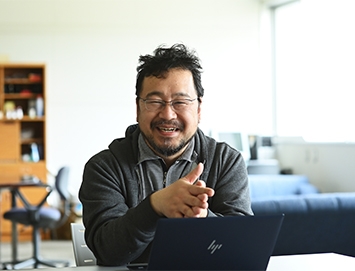
Though not everything always went smoothly, he fortunately passed his graduation exam. One day, while Dr. Uesugi was still a doctoral student at Tokyo Institute of Technology, he received a offer from Osaka University asking him to build an X-ray CT system using SPring-8.
Osaka University's request was: "We want to use SPring-8 to extract information from the interior of meteorites and rocks without breaking them. However, there is no one available to take on this project. We need someone who is both physically strong and can also use a computer.” Dr. Uesugi was then chosen for that. He said to them, “It sounds very interesting. I would like to take it on.” Soon afterward he moved his research work to X-ray imaging at SPring-8.
The job of fabricating the X-ray CT system was just as interesting as he expected. He created his own software, bought cameras and components, wrote sequences for taking CT data, and built the equipment. After about 6 months it worked well enough to reconstruct images; and after about a year, users began using that equipment to acquire data.
“At that time, I had lots of energy to devote to my work, so I was doing the experiments along with the users for about 18 hours a day. That was quite interesting work. Well, it all started by chance, but from that starting point, interesting things unfolded,” says Dr. Uesugi. Before he knew it, he found himself fully immersed in this work.
Analysis of Ryugu particles prepared over 5 years
Now let's hear about the most impressive research he ever accomplished.
“In terms of research, I would say it is the sample brought back from the asteroid Ryugu. That job had been in the works for 6 years including the preparation time. The analysis itself was done in the last one year or so, but we had to do 5 years of preparation before making that analysis.”
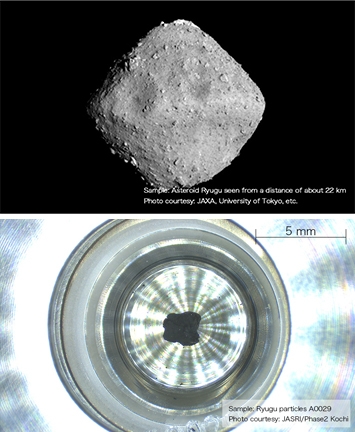
In addition to SPring-8, four other teams from JAXA, the National Institute of Polar Research, the Institute for Molecular Science, and JAMSTEC were involved in the preparation for analyzing Ryugu samples. About 6 years ago in 2017, these five organizations signed an agreement and began preparing what they needed to do in order to analyze the Ryugu samples.
In this mixed team, everything was discussed from scratch, for example, “How do we transfer the samples to be brought back from Ryugu to the tray in JAXA's clean chamber?” or “How do we divide a sample into smaller pieces?" or "How do we bring it to SPring-8?” Experiments were conducted in a vacuum or in nitrogen, so we had to build the special equipment and containers and think about what procedures to use. We had to incorporate new techniques into the process whenever needed.
“Basically, one person would come up with an idea, and the others responded to it with answers like, 'Well, in that case we can use this,’ and when it came to the stage of ‘let’s make a prototype,’ we all started suggesting specific ideas and if the prototype was good, we would go ahead with it, and if not, we would come up with another idea,” says Dr. Uesugi. He himself contributed to the team by designing a sample holder made from carbon nanotubes and a transport container to carry samples without having to expose them to the earth’s atmosphere.
When asked what the most exciting part of this research project was, Dr. Uesugi replied, “Well, as you might expect, that's the moment when we acquired data at the beamline."
Gathering know-how from the five teams led to coming up with a means for transporting the sample and doing dry runs helped us to face the real thing. Then, at the final stage when we put the transported sample in a special container and placed it in the experimental equipment built in SPring-8, “All of us started taking pictures,” says Dr. Uesugi with a smile.
“The laboratory is small enough to hold only two or three people at once. So more than a dozen team members had to wait in the room next door and take turns entering the laboratory in order to capture the historic moment with a camera.”
“The Ryugu samples are in sizes from 3 to 10 millimeters. The samples placed in the experimental system were scanned by X-ray CT to get tomographic images which were then displayed on a large monitor installed in the next room. As the images shown, people start to comment saying, ‘Oh, I can see it, I can see it.’ or ‘It's flat and smooth, isn't it?’ There were several samples and we proceeded with the discussion while viewing the CT images displayed one by one on the monitor.”
“An entire CT image doesn’t appear all at once and it takes time for the calculation. We can initially see a slice image, then we have to wait about 15 minutes before the entire image is shown.”
“As we were viewing the sliced images in order from top to bottom, voices could be heard from around the room saying, ‘Oh, Oh,’ ‘Oh, it's cracked,’ ‘Oh, what is that?’ ‘What is this cluster?’ When a meteorite expert who was there commented, ‘This could be that...’ or ‘This could be this...’ further discussion followed in response to those comments. We were also connected online with members in the UK to exchange ideas with them.”
Three evidence patterns pointing to the presence of water
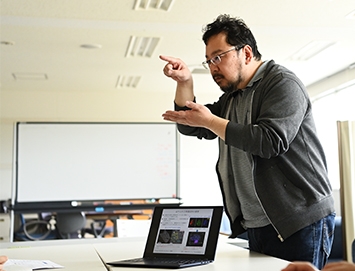
I was drawn into this discussion just as if I were a member of their analysis team.
The news reported that "traces of water were found on Ryugu.” How did they find out about that?
“On the CT images of Ryugu particles, heavier materials appear lighter and lighter materials appear darker. Those images prove that there are carbonate minerals, however, these cannot be produced unless water was present,” Dr. Uesugi explains.
“There were also lots of clay minerals. The presence of clay minerals means there was once water. Clay minerals can hold lots of water in its interlayer. There are often clay-like areas on school grounds and such places. If you pour water there, you’ll notice that the clay is easily diluted with water. We still don't know how much water was present in the Ryugu particles, but we can say there is indeed evidence that water was present.”
The SPring-8 experiment revealed that there are three water evidence patterns: “has been wet,” “contains water,” and “water itself is present.” Since analysis from different approaches is underway at research facilities other than SPring-8, the overall amount of water will become clearer in the future. Incidentally, this discovery is expected to provide clues that will greatly advance our understanding of the origins of the Earth and life.
It seems that these findings are not immediately obvious from just looking at the images, but rather gradually emerge as everyone discusses them together.
“I can build experimental equipment to produce images but I'm not an expert on meteorites or minerals so I can't interpret them. So, while displaying the images one after another, I ask the specialists, 'What is this?' A discussion then begins with someone commenting on ‘this and that.’ To tell the truth, it was like having a lecture on meteorites on the spot," says Dr. Uesugi with a laugh.
Until we are totally convinced that the first data we acquired is correct
I also asked Dr. Uesugi if there is anything that has impressed him before the Ryugu particle experiments.
Dr. Uesugi replied, “Yes, there was a rubber material experiment I ran with researchers from a rubber tire manufacturer. Their request was, ‘We want to see the actual rubber break-down process.’ Their goal was to develop tires that wouldn’t easily wear out while driving along the road yet would safely stop the vehicle.”
Dr. Uesugi continued saying, “What was amazing about these guys was that they were using a supercomputer, scattering spectroscopy and just about everything else to try to get an all-around understanding of the physical properties of rubber.” CT images of the rubber breakdown process taken at SPring-8 also played a major role.
“I made a device that pulls and stretches a piece of rubber about 1 millimeter thick and spins it in that state while capturing CT images of it. This device cost quite a bit of money, but besides that manufacturer, there was another user who also wanted to use it, so I thought if I actually made it, it would prove useful for others. We then captured the data we needed while pulling and stretching the rubber 2 micrometers per second just as we wanted.”
Looking at the CT images taken in this way, something had happened that no one had ever seen before.
“Well, we and everyone else thought that rubber will tear if pulled and stretched hard. However, the CT images showed that there were 'holes' in the area where the tear appeared. They were black and gray holes.”
Dr. Uesugi and his colleagues repeated their calculations again to see if there was some kind of mistake. However, the results remained the same. They then tried capturing images under different conditions but those "holes" still appeared. He noticed that repeating the calculations took a while and the time was then midnight. Dr. Uesugi gave up for the time being and went home.
When he went to work the next morning, a researcher from the tire manufacturer called him and said, "Mr. Uesugi, I understand what is happening. The gray holes might look broken but are probably not actually broken."
“No one but a rubber tire manufacturer could ever have noticed this and come up with that idea. Moreover, the data would absolutely never have become visible for us to actually see without SPring-8. We later found out that we were likely the first persons in the world to ever see that data,” says Dr. Uesugi.
A so-called "World first" seems to be this kind of phenomenon. It takes time and wears on your nerves before one finally becomes convinced that the data taken for the first time is not false and is not some kind of mistake.
This tire manufacturer company took advantage of these results to come up with a new way of making rubber and succeeded in developing a product that satisfies needs for both reduced fuel consumption and greater durability. Dr. Uesugi recalls, “Without those research results, they probably wouldn't have made this dramatic progress that led to a success story.” These types of hard-to-get experiences seem to be the driving force that makes Dr. Uesugi want to continue this work.
“It's really interesting to work with real professionals. It is also a great experience to meet interesting people and do fascinating research together with them. We also make these results open and available to the outside world so that we can say, 'Hey, this is what we've done.’ We also receive requests from diverse outside fields with people saying, 'We'd like to take a close look at this.’ Since these requests have been continuing in an ever-expanding cycle, I’m intensely busy but one thing that never changes is that it’s always interesting work.”
How a baseball boy switched over to a researcher career
When I asked Dr. Uesugi about his childhood, I learned some surprising things. He says, "I started out playing softball in the third grade at elementary school, and played baseball all the way through middle school, high school, and college." Well then, what is it that made this baseball boy switch his career path to become a researcher?
“When I was a university undergraduate student, something happened that kept tugging at my mind and wouldn’t let go. I was getting hands-on practice using X-rays and when I first acquired mineral data and analyzed it, I found I was able to determine the lattice constant or parameter of the crystal with high precision down to two digits below an angstrom (1 angstrom = 0.1 nanometers or 10⁻¹⁰ meters).”
Minerals have atoms arranged in a neat and orderly sequence. When Dr. Uesugi did hands-on practice using an X-ray camera capable of measuring what kinds of atoms are lined up at what distance, the measured values he obtained matched the reference values to two digits below the decimal point in angstroms.
Upon seeing these results, he started wondering, "What happened here?" "How is it that an X-ray camera can perform such mysterious feats?" The impact he got from this was huge, and Dr. Uesugi's whole spirit was caught up by the feeling that "This is something I can’t ignore and must master." With that feeling growing ever stronger, he joined the staff at the university mineralogy research lab and continued on toward a master's course in that lab.
“When I joined the lab, I encountered another amazing simulation technology and immediately wanted to work on that. It was in fact so interesting that I found it totally absorbing and couldn’t think about anything else,” says Dr. Uesugi with a huge laugh.
After that, he went on to take a doctoral course and, as mentioned earlier, was offered a position by Osaka University involving work with SPring-8.
If we all work together, we can double the fun and halve the pain!
Lastly, let's ask Dr. Uesugi about the approach he takes regarding his work.
“I don't really have a specific approach, but if I have to put it into words, it would be 'Let's do it right'. I often keep telling myself, ‘Let’s do it right.’ I'm the type of person who gets totally involved when he finds something interesting, which makes me persistent when I want to do something. This motivates me and spurs me on even further to keep doing things the right way.”
When I asked him if he had a message to give to the young people of today, he first replied, "I don’t want to sound too preachy..." but then he continued on saying, “I tell young people, for example, ‘Let’s work on something fun and interesting together,’ and also ‘What’s that? That’s a really interesting phenomenon. Let's all try to examine it together' and ‘If you want to do it, you can use our equipment.’ This might be a strange analogy, but there is a saying that a good marriage doubles our joy and halves our grief. Research works the same way and that’s the point I want to get across."
Do fun things together and if things get tough, share the pain with everyone and it will shrink away.
“Today's young people are smart, so on the surface they seem to be quite self-complete as individuals. But I think it would be better if they start out by saying or doing something stupid and then have someone tell them, ‘You are an idiot!’ so they can then start maturing from that point onward, but then that's probably not a cool way for them to approach growing up."
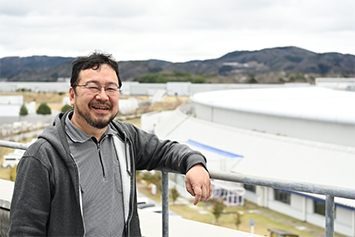
Whether it's cool or not, Dr. Uesugi's message to young people is to start with a light approach to get everyone around more easily involved and to have more fun.
Don't be too smart, share your joys and pains with others. The struggle to reveal a world's first discovery on the front lines of research usually starts from a humble and interesting approach of people. This approach seems to be the key that allows Dr. Uesugi to satisfy his endless curiosity.




